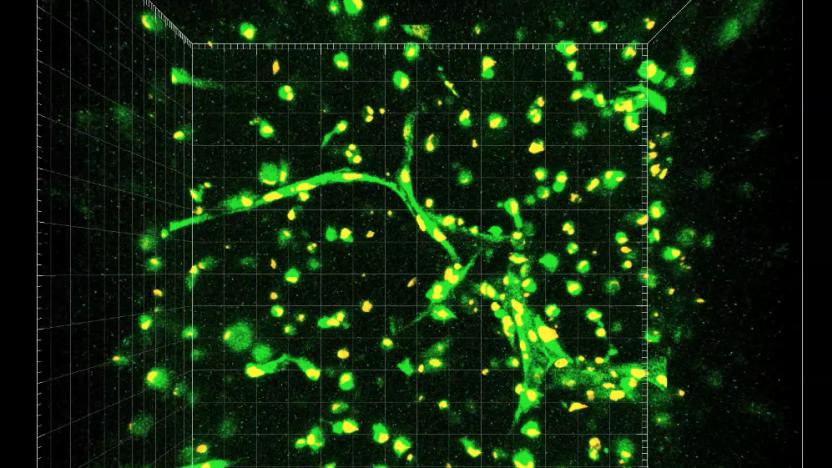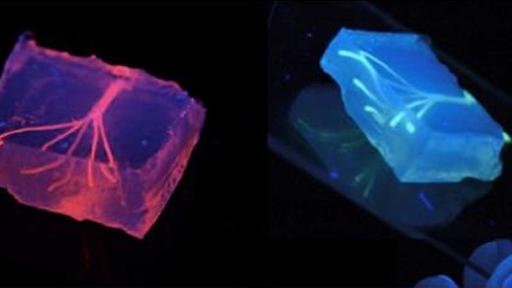BloodVessels
Latest

Researchers are closer to working capillaries in 3D-printed organs
Researchers have brought 3D-printed organ and tissue capabilities a long way, but the technology still faces a few challenges. A major one is how to incorporate blood vessels into bioprinted tissue. Living tissue needs a blood supply nearby because without blood to bring in nutrients and take away waste, biological cells will die. Researchers have been able to print larger blood vessels, but functional small vessels like capillaries have been much harder to create and sustain. However, researchers at Rice University and Baylor College of Medicine have developed a new technique, published in Biomaterials Science, that might make it possible.

ICYMI: Fast brain upload, mind-control monkeys & more
#fivemin-widget-blogsmith-image-222051{display:none;} .cke_show_borders #fivemin-widget-blogsmith-image-222051, #postcontentcontainer #fivemin-widget-blogsmith-image-222051{width:570px;display:block;} try{document.getElementById("fivemin-widget-blogsmith-image-222051").style.display="none";}catch(e){}Today on In Case You Missed It: Researchers at HRL Labs have developed a system to upload information to your brain using electrical signals already mapped from an expert's mind. Duke University is testing a wireless brain-machine interface that allows monkeys to steer a wheelchair with their mind, which they were able to do while also improving their skills over time. Cardiologists have a new tool to roto-rooter blood vessels filled with plague in the first FDA approved device that helps surgeons see inside vessels with a built-in camera.

Instant man-made blood vessels could speed up drug discovery
Man-made tissues and organs are useful tools for scientists seeking to understand and potentially fix the human body. One area in which they could have a significant impact is drug discovery, allowing researchers to test therapies in living models prior to animal and human trials. A group of biomedical engineers at Duke University are particularly interested in this use case, leading them to develop a new technique for creating working blood vessels in the lab. And what previous methods took six to eight weeks to achieve, the researchers have managed to condense into a matter of hours.

Scientists 3D print 'live' blood vessels
It's no longer a rare feat to 3D print blood vessels. Printing vessels that act like the real deal, however, has been tricky... until now. Lawrence Livermore researchers have successfully 3D printed blood vessels that deliver nutrients and self-assemble like they would in a human body. The key is to print an initial structure out of cells and other organic material, and then to augment it with bio ink and other body-friendly materials. With enough time, everything joins up and behaves naturally.

3D-printed vascular systems help doctors practice for your surgery
It's safe to say that you want your doctors to know exactly what they're doing when performing surgery. But how do they train for a vascular operation, which is both extremely tricky and unique to your anatomy? By using 3D printing, that's how. MakerBot's parent company Stratasys is teaming with physicians to create 3D-printed replicas of patients' vascular systems, giving surgeons a way to practice before they poke around your blood vessels. The models use flexible photopolymers (that is, light-sensitive polymers) to recreate the feel of organic tissue, so you don't have to worry that the surgery team is only used to working with hardened plastic.

Scientists have figured out how to create blood vessels in 3D printed organs
While 3D-printed organs sound like a great idea -- imagine no longer waiting around for a transplant -- a major hurdle for printing internal ones thus far have been creating intricate blood vessels and ventricles that are required for the organ to actually, you know, work. Now, a collaboration between scientists from the University of Sydney, Harvard, Stanford and MIT have discovered a way to do just that. The team used an advanced bioprinter to create tiny interconnected fibers, and then coated them in human endothelial cells and a protein-based material, which hardens under light. They then removed the fibers, and voilà -- a network of capillaries was born.

Researchers are using 3D printers to make blood vessels
There has been talk of printing blood vessels for a few years, but it's tricky to make tissue that fits the complex shapes of a human body while remaining effective. However, a research team at Brigham and Women's Hospital may have licked that problem: they've 3D printed vessels using a new technique that allows for intricate yet capable designs. Their process first prints agarose (sugar-based molecule) fibers as templates for the vessels, and then covers that in jelly-like hydrogel to produce a cast. Since the agarose is sturdy, scientists can pull it out to create channels without damaging any cells inside the gel; the resulting vessels are much better at transporting liquid and otherwise behaving like the real deal.

Print your own blood vessels, no need for red toner
Barely 24 hours after we told you about printing your own bones, the franken-science continues with the announcement that blood vessels are next on the body-parts-you-can-print list. Unsurprisingly, you'll need more than just regular toner if you want to start printing your own at home, but pioneering work by application-oriented research organization Fraunhofer has claimed to have cracked it by adding some good old 'two-photon polymerization' into the mix -- yeah, obvious once you know. The added photon special sauce is what makes the printed synthetic tubes biofunctionalized, which in turn enables living body cells to dock onto them -- we're guessing that's important. Sounds cute, but how long until we can start printing whole people -- Weird Science, anyone?

Scientists develop blood swimming 'microspiders' to heal injuries, deliver drugs
Scientists at Penn State would like to release tiny spiders into your blood -- no, it's not the premise for a new horror movie, but rather, it's a medical breakthrough. The spider-like machines are less than a micrometer wide (just so you know, a red blood cell is around six to ten micrometers), and are designed to travel through veins delivering drugs and a little TLC to damaged areas -- not a totally new concept, per se, but even minor advancements can open up all sorts of new doors for troubled patients. Made of half gold, half silica, these microspiders are self-propelled by a molecule called the Grubbs catalyst, which scientists can control directionally using chemicals. Although still in the preliminary phases, lead researcher Ayusman Sen hopes to one day attach the creepy crawlers to nanobots, which could maneuver through the body to detect tumors, helping the immune system and scrubbing vessels clean of plaque. Not like that's doing anything to diffuse your arachnophobia, but hey...






